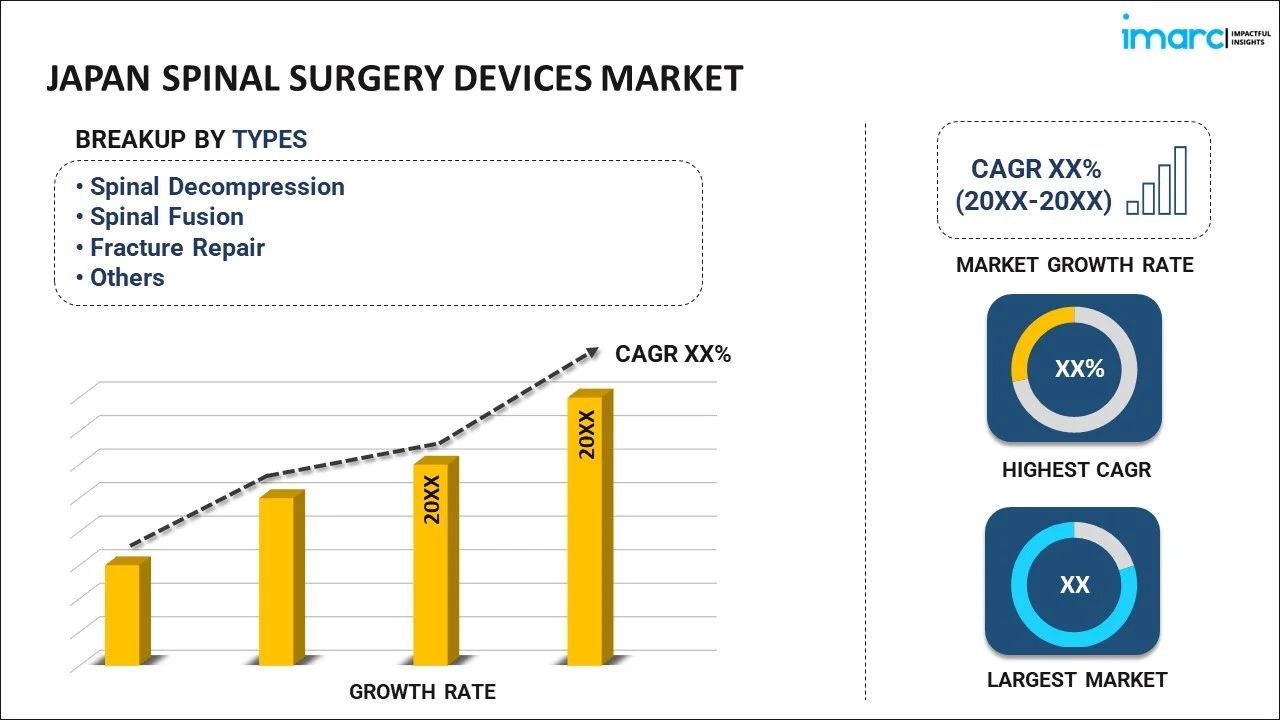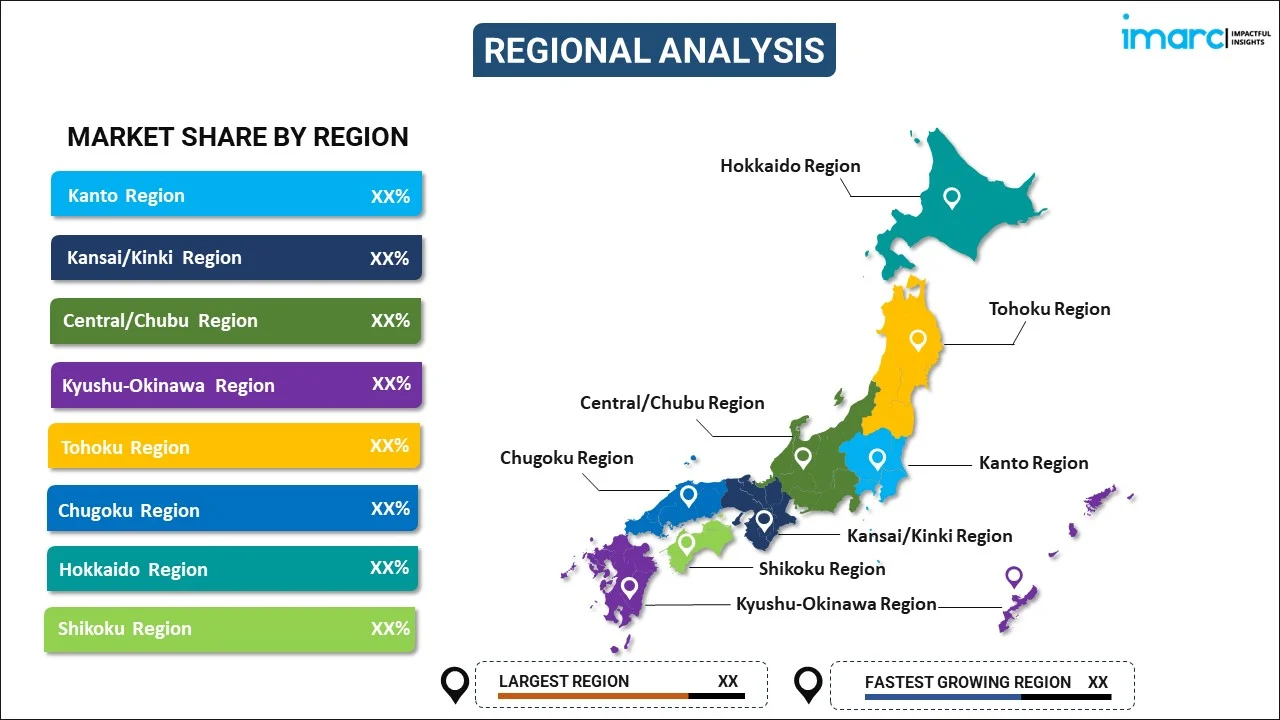
Japan Spinal Surgery Devices Market Report by Type (Spinal Decompression, Spinal Fusion, Fracture Repair, and Others), and Region 2025-2033
Market Overview:
Japan spinal surgery devices market size reached USD 891.0 Million in 2024. Looking forward, IMARC Group expects the market to reach USD 1,592.0 Million by 2033, exhibiting a growth rate (CAGR) of 6.7% during 2025-2033. The growing incidences of spinal disorders, coupled with the rising integration of third-dimensional (3D) imaging, robotics, and artificial intelligence (AI) technologies with surgical devices, are primarily driving the market growth.
|
Report Attribute
|
Key Statistics
|
|---|---|
|
Base Year
|
2024
|
|
Forecast Years
|
2025-2033
|
|
Historical Years
|
2019-2024
|
| Market Size in 2024 | USD 891.0 Million |
| Market Forecast in 2033 | USD 1,592.0 Million |
| Market Growth Rate 2025-2033 | 6.7% |
Spinal surgery devices are specialized medical tools tailored to manage and rectify spinal conditions and deformities. These devices exhibit essential features such as adaptability, resilience, and harmony with the human spine. They are typically crafted from materials like titanium, cobalt-chromium alloys, or bio-absorbable materials, ensuring optimal integration within the vertebral column. Spinal surgery devices encompass a diverse array of designs, including fusion devices like rods and screws, disc replacements for degenerated or herniated discs, and stabilization systems for spinal alignment. Their primary role is to restore spinal alignment, alleviate pain, and enhance the overall spinal function for individuals grappling with conditions like scoliosis, spinal stenosis, or herniated discs.
Japan Spinal Surgery Devices Market Trends:
The expanding geriatric population, who are more prone to musculoskeletal issues such as osteoarthritis and fractures, is augmenting the Japan spinal surgery devices market. Numerous joint replacement surgeries, including hip and knee implants, particularly for elderly individuals to maintain their quality of life and mobility are acting as significant growth-inducing factors. Additionally, a surge in sports and physical activity participation has led to a higher incidence of sports-related injuries, thereby propelling the demand for spinal surgery devices. Besides this, numerous technological advancements and innovations that encompass materials, implant designs, and surgical techniques are also propelling the market growth. Materials such as stainless steel and bioresorbable polymers are progressively adopted to craft implants that meld harmoniously with human tissues. Minimal intervention techniques, supported by state-of-the-art visualization and tracking tools, diminish surgical distress and healing duration. Additive manufacturing techniques have transformed prosthetic production, facilitating customized implants for improved results. Furthermore, the growing incorporation of sophisticated materials like high-tensile strength alloys augments the durability of bone fixations. Technological innovations not only elevate prosthetic efficacy but also boost patient contentment, rendering it a pivotal propellant of market expansion. Moreover, numerous other factors, such as a better understanding of spinal health, wide adoption of minimally invasive yet potent therapies, and an emphasis on environmentally considerate, biologically harmonious materials will continue to drive the spinal surgery device market in Japan over the coming years.
Japan Spinal Surgery Devices Market Segmentation:
IMARC Group provides an analysis of the key trends in each segment of the market, along with forecasts at the country level for 2025-2033. Our report has categorized the market based on type.
Type Insights:

- Spinal Decompression
- Corpectomy
- Discectomy
- Laminotomy
- Others
- Spinal Fusion
- Fracture Repair
- Others
The report has provided a detailed breakup and analysis of the market based on the type. This includes spinal decompression (corpectomy, discectomy, laminotomy, and others), spinal fusion, fracture repair, and others.
Regional Insights:

- Kanto Region
- Kansai/Kinki Region
- Central/ Chubu Region
- Kyushu-Okinawa Region
- Tohoku Region
- Chugoku Region
- Hokkaido Region
- Shikoku Region
The report has also provided a comprehensive analysis of all the major regional markets, which include Kanto Region, Kansai/Kinki Region, Central/ Chubu Region, Kyushu-Okinawa Region, Tohoku Region, Chugoku Region, Hokkaido Region, and Shikoku Region.
Competitive Landscape:
The market research report has also provided a comprehensive analysis of the competitive landscape in the market. Competitive analysis such as market structure, key player positioning, top winning strategies, competitive dashboard, and company evaluation quadrant has been covered in the report. Also, detailed profiles of all major companies have been provided.
Japan Spinal Surgery Devices Market Report Coverage:
| Report Features | Details |
|---|---|
| Base Year of the Analysis | 2024 |
| Historical Period | 2019-2024 |
| Forecast Period | 2025-2033 |
| Units | Million USD |
| Scope of the Report | Exploration of Historical Trends and Market Outlook, Industry Catalysts and Challenges, Segment-Wise Historical and Future Market Assessment:
|
| Types Covered |
|
| Regions Covered | Kanto Region, Kansai/Kinki Region, Central/ Chubu Region, Kyushu-Okinawa Region, Tohoku Region, Chugoku Region, Hokkaido Region, Shikoku Region |
| Customization Scope | 10% Free Customization |
| Post-Sale Analyst Support | 10-12 Weeks |
| Delivery Format | PDF and Excel through Email (We can also provide the editable version of the report in PPT/Word format on special request) |
Key Questions Answered in This Report:
- How has the Japan spinal surgery devices market performed so far and how will it perform in the coming years?
- What has been the impact of COVID-19 on the Japan spinal surgery devices market?
- What is the breakup of the Japan spinal surgery devices market on the basis of type?
- What are the various stages in the value chain of the Japan spinal surgery devices market?
- What are the key driving factors and challenges in the Japan spinal surgery devices market?
- What is the structure of the Japan spinal surgery devices market and who are the key players?
- What is the degree of competition in the Japan spinal surgery devices market?
Key Benefits for Stakeholders:
- IMARC’s industry report offers a comprehensive quantitative analysis of various market segments, historical and current market trends, market forecasts, and dynamics of the Japan spinal surgery devices market from 2019-2033.
- The research report provides the latest information on the market drivers, challenges, and opportunities in the Japan spinal surgery devices market.
- Porter's five forces analysis assist stakeholders in assessing the impact of new entrants, competitive rivalry, supplier power, buyer power, and the threat of substitution. It helps stakeholders to analyze the level of competition within the Japan spinal surgery devices industry and its attractiveness.
- Competitive landscape allows stakeholders to understand their competitive environment and provides an insight into the current positions of key players in the market.
Need more help?
- Speak to our experienced analysts for insights on the current market scenarios.
- Include additional segments and countries to customize the report as per your requirement.
- Gain an unparalleled competitive advantage in your domain by understanding how to utilize the report and positively impacting your operations and revenue.
- For further assistance, please connect with our analysts.
 Inquire Before Buying
Inquire Before Buying
 Speak to an Analyst
Speak to an Analyst
 Request Brochure
Request Brochure
 Request Customization
Request Customization




.webp)




.webp)












